Knowledge Management Principles: Report and Analysis of Concepts
VerifiedAdded on 2023/02/01
|9
|1837
|91
Report
AI Summary
This report provides a comprehensive analysis of knowledge management principles, addressing key concepts such as tacit and explicit knowledge, communities of practice (CoPs), and knowledge sharing systems. The report begins by differentiating between tacit and explicit knowledge, using the example of purchasing a Holden Commodore to illustrate the importance of both types. It then defines CoPs and explores their benefits, particularly in healthcare settings, supported by data analysis. The report also examines the rationale behind knowledge sharing systems between rival organizations, highlighting potential mutual benefits. Finally, it critiques a scenario involving a decrease in ROI from a knowledge management investment and proposes a detailed plan for improvement, including identifying business problems, preparing for change, creating a KM team, conducting knowledge audits, defining solution features, implementing building blocks, and linking knowledge to relevant people. The report is based on the concepts from Chapter 2, 3, 4 and 5 of the prescribed textbook.
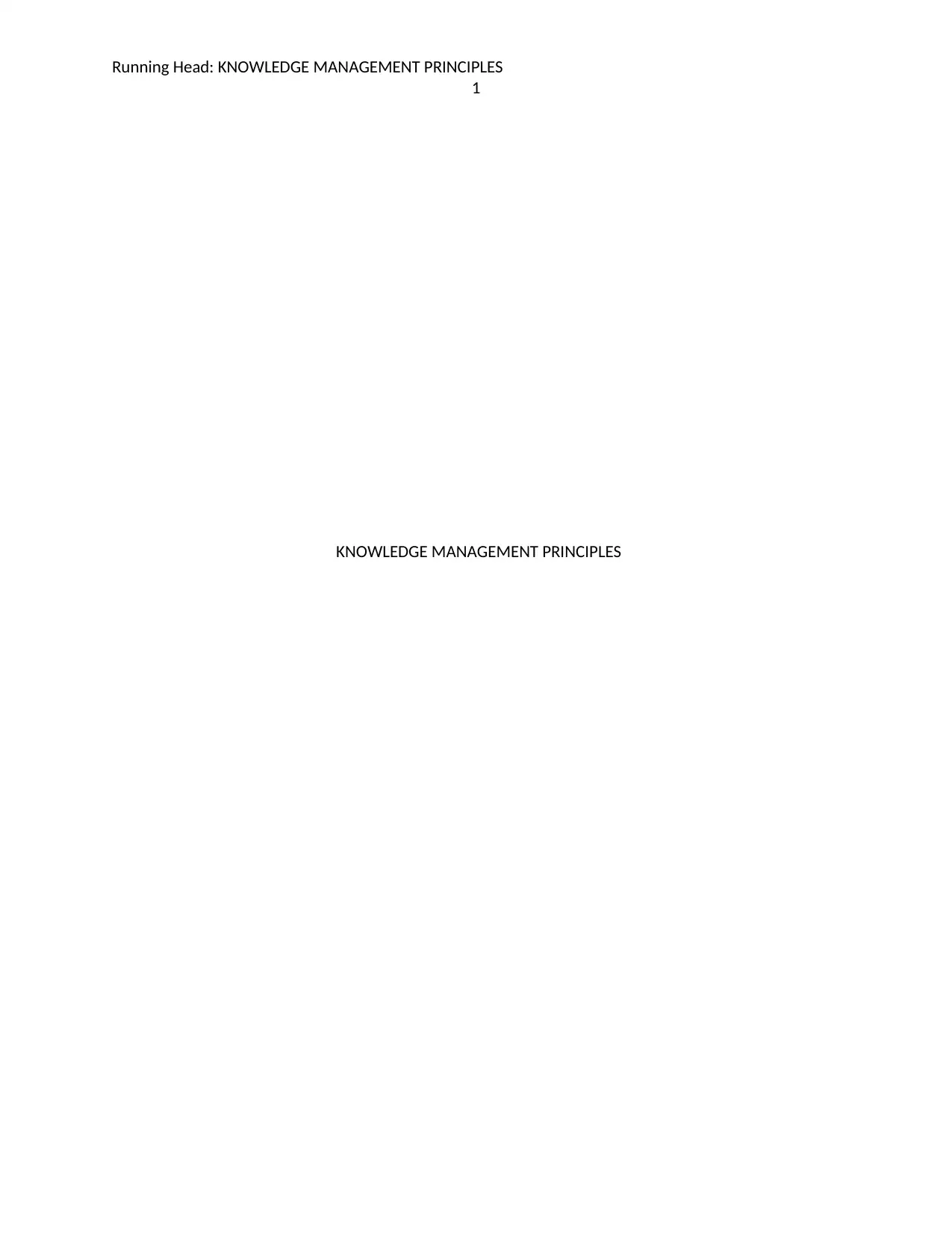
Running Head: KNOWLEDGE MANAGEMENT PRINCIPLES
1
KNOWLEDGE MANAGEMENT PRINCIPLES
1
KNOWLEDGE MANAGEMENT PRINCIPLES
Paraphrase This Document
Need a fresh take? Get an instant paraphrase of this document with our AI Paraphraser
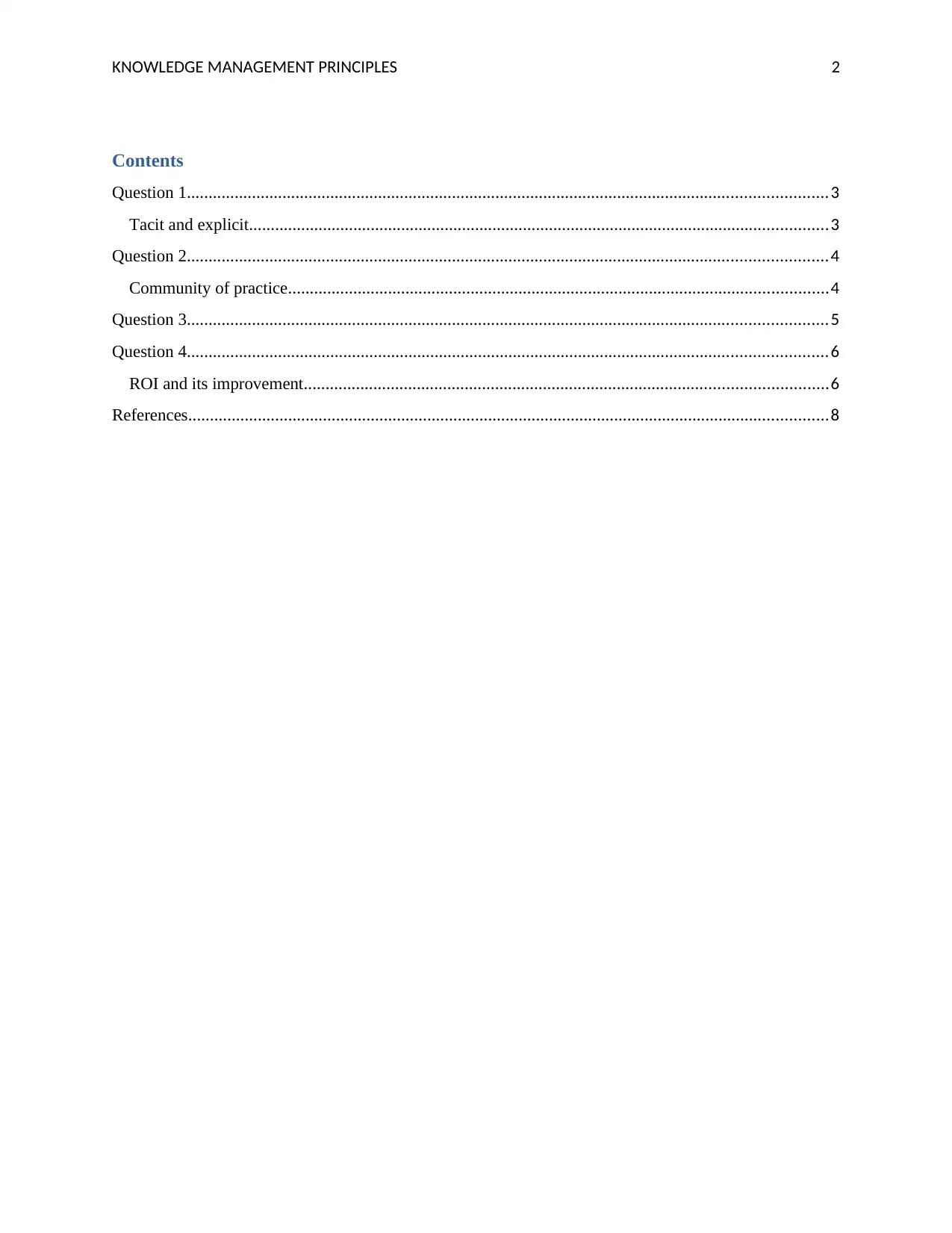
KNOWLEDGE MANAGEMENT PRINCIPLES 2
Contents
Question 1...................................................................................................................................................3
Tacit and explicit.....................................................................................................................................3
Question 2...................................................................................................................................................4
Community of practice............................................................................................................................4
Question 3...................................................................................................................................................5
Question 4...................................................................................................................................................6
ROI and its improvement........................................................................................................................6
References...................................................................................................................................................8
Contents
Question 1...................................................................................................................................................3
Tacit and explicit.....................................................................................................................................3
Question 2...................................................................................................................................................4
Community of practice............................................................................................................................4
Question 3...................................................................................................................................................5
Question 4...................................................................................................................................................6
ROI and its improvement........................................................................................................................6
References...................................................................................................................................................8
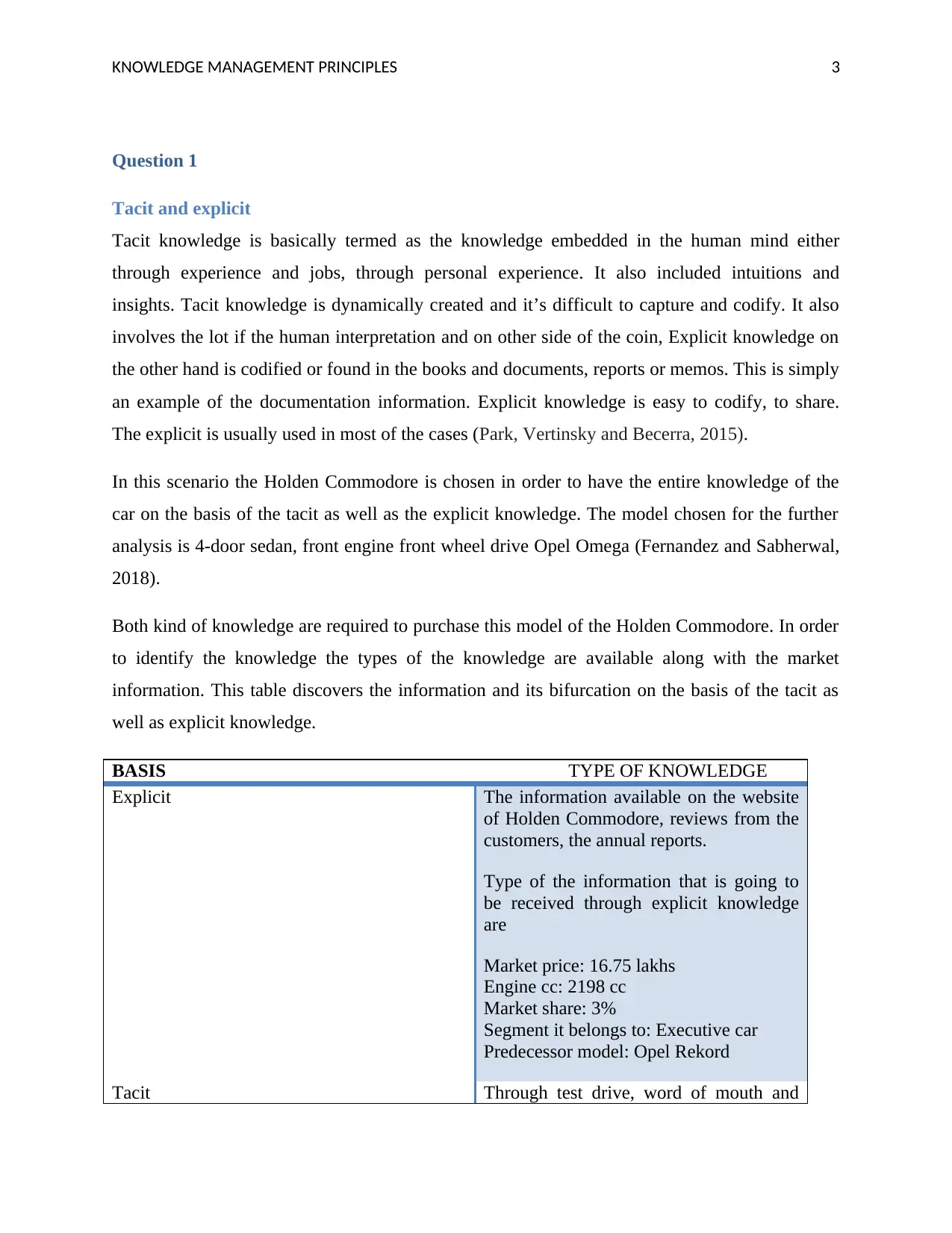
KNOWLEDGE MANAGEMENT PRINCIPLES 3
Question 1
Tacit and explicit
Tacit knowledge is basically termed as the knowledge embedded in the human mind either
through experience and jobs, through personal experience. It also included intuitions and
insights. Tacit knowledge is dynamically created and it’s difficult to capture and codify. It also
involves the lot if the human interpretation and on other side of the coin, Explicit knowledge on
the other hand is codified or found in the books and documents, reports or memos. This is simply
an example of the documentation information. Explicit knowledge is easy to codify, to share.
The explicit is usually used in most of the cases (Park, Vertinsky and Becerra, 2015).
In this scenario the Holden Commodore is chosen in order to have the entire knowledge of the
car on the basis of the tacit as well as the explicit knowledge. The model chosen for the further
analysis is 4-door sedan, front engine front wheel drive Opel Omega (Fernandez and Sabherwal,
2018).
Both kind of knowledge are required to purchase this model of the Holden Commodore. In order
to identify the knowledge the types of the knowledge are available along with the market
information. This table discovers the information and its bifurcation on the basis of the tacit as
well as explicit knowledge.
BASIS TYPE OF KNOWLEDGE
Explicit The information available on the website
of Holden Commodore, reviews from the
customers, the annual reports.
Type of the information that is going to
be received through explicit knowledge
are
Market price: 16.75 lakhs
Engine cc: 2198 cc
Market share: 3%
Segment it belongs to: Executive car
Predecessor model: Opel Rekord
Tacit Through test drive, word of mouth and
Question 1
Tacit and explicit
Tacit knowledge is basically termed as the knowledge embedded in the human mind either
through experience and jobs, through personal experience. It also included intuitions and
insights. Tacit knowledge is dynamically created and it’s difficult to capture and codify. It also
involves the lot if the human interpretation and on other side of the coin, Explicit knowledge on
the other hand is codified or found in the books and documents, reports or memos. This is simply
an example of the documentation information. Explicit knowledge is easy to codify, to share.
The explicit is usually used in most of the cases (Park, Vertinsky and Becerra, 2015).
In this scenario the Holden Commodore is chosen in order to have the entire knowledge of the
car on the basis of the tacit as well as the explicit knowledge. The model chosen for the further
analysis is 4-door sedan, front engine front wheel drive Opel Omega (Fernandez and Sabherwal,
2018).
Both kind of knowledge are required to purchase this model of the Holden Commodore. In order
to identify the knowledge the types of the knowledge are available along with the market
information. This table discovers the information and its bifurcation on the basis of the tacit as
well as explicit knowledge.
BASIS TYPE OF KNOWLEDGE
Explicit The information available on the website
of Holden Commodore, reviews from the
customers, the annual reports.
Type of the information that is going to
be received through explicit knowledge
are
Market price: 16.75 lakhs
Engine cc: 2198 cc
Market share: 3%
Segment it belongs to: Executive car
Predecessor model: Opel Rekord
Tacit Through test drive, word of mouth and
⊘ This is a preview!⊘
Do you want full access?
Subscribe today to unlock all pages.

Trusted by 1+ million students worldwide
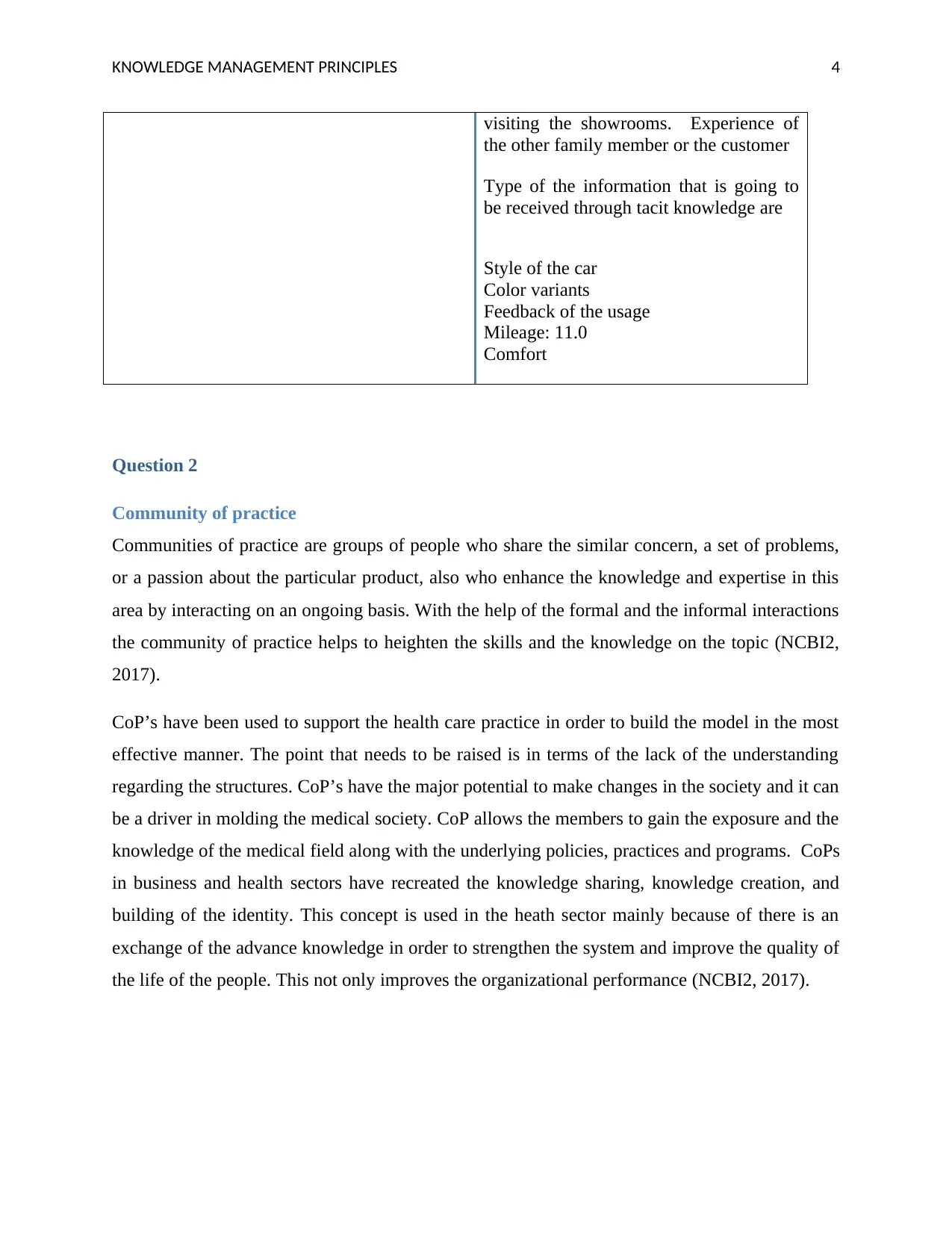
KNOWLEDGE MANAGEMENT PRINCIPLES 4
visiting the showrooms. Experience of
the other family member or the customer
Type of the information that is going to
be received through tacit knowledge are
Style of the car
Color variants
Feedback of the usage
Mileage: 11.0
Comfort
Question 2
Community of practice
Communities of practice are groups of people who share the similar concern, a set of problems,
or a passion about the particular product, also who enhance the knowledge and expertise in this
area by interacting on an ongoing basis. With the help of the formal and the informal interactions
the community of practice helps to heighten the skills and the knowledge on the topic (NCBI2,
2017).
CoP’s have been used to support the health care practice in order to build the model in the most
effective manner. The point that needs to be raised is in terms of the lack of the understanding
regarding the structures. CoP’s have the major potential to make changes in the society and it can
be a driver in molding the medical society. CoP allows the members to gain the exposure and the
knowledge of the medical field along with the underlying policies, practices and programs. CoPs
in business and health sectors have recreated the knowledge sharing, knowledge creation, and
building of the identity. This concept is used in the heath sector mainly because of there is an
exchange of the advance knowledge in order to strengthen the system and improve the quality of
the life of the people. This not only improves the organizational performance (NCBI2, 2017).
visiting the showrooms. Experience of
the other family member or the customer
Type of the information that is going to
be received through tacit knowledge are
Style of the car
Color variants
Feedback of the usage
Mileage: 11.0
Comfort
Question 2
Community of practice
Communities of practice are groups of people who share the similar concern, a set of problems,
or a passion about the particular product, also who enhance the knowledge and expertise in this
area by interacting on an ongoing basis. With the help of the formal and the informal interactions
the community of practice helps to heighten the skills and the knowledge on the topic (NCBI2,
2017).
CoP’s have been used to support the health care practice in order to build the model in the most
effective manner. The point that needs to be raised is in terms of the lack of the understanding
regarding the structures. CoP’s have the major potential to make changes in the society and it can
be a driver in molding the medical society. CoP allows the members to gain the exposure and the
knowledge of the medical field along with the underlying policies, practices and programs. CoPs
in business and health sectors have recreated the knowledge sharing, knowledge creation, and
building of the identity. This concept is used in the heath sector mainly because of there is an
exchange of the advance knowledge in order to strengthen the system and improve the quality of
the life of the people. This not only improves the organizational performance (NCBI2, 2017).
Paraphrase This Document
Need a fresh take? Get an instant paraphrase of this document with our AI Paraphraser
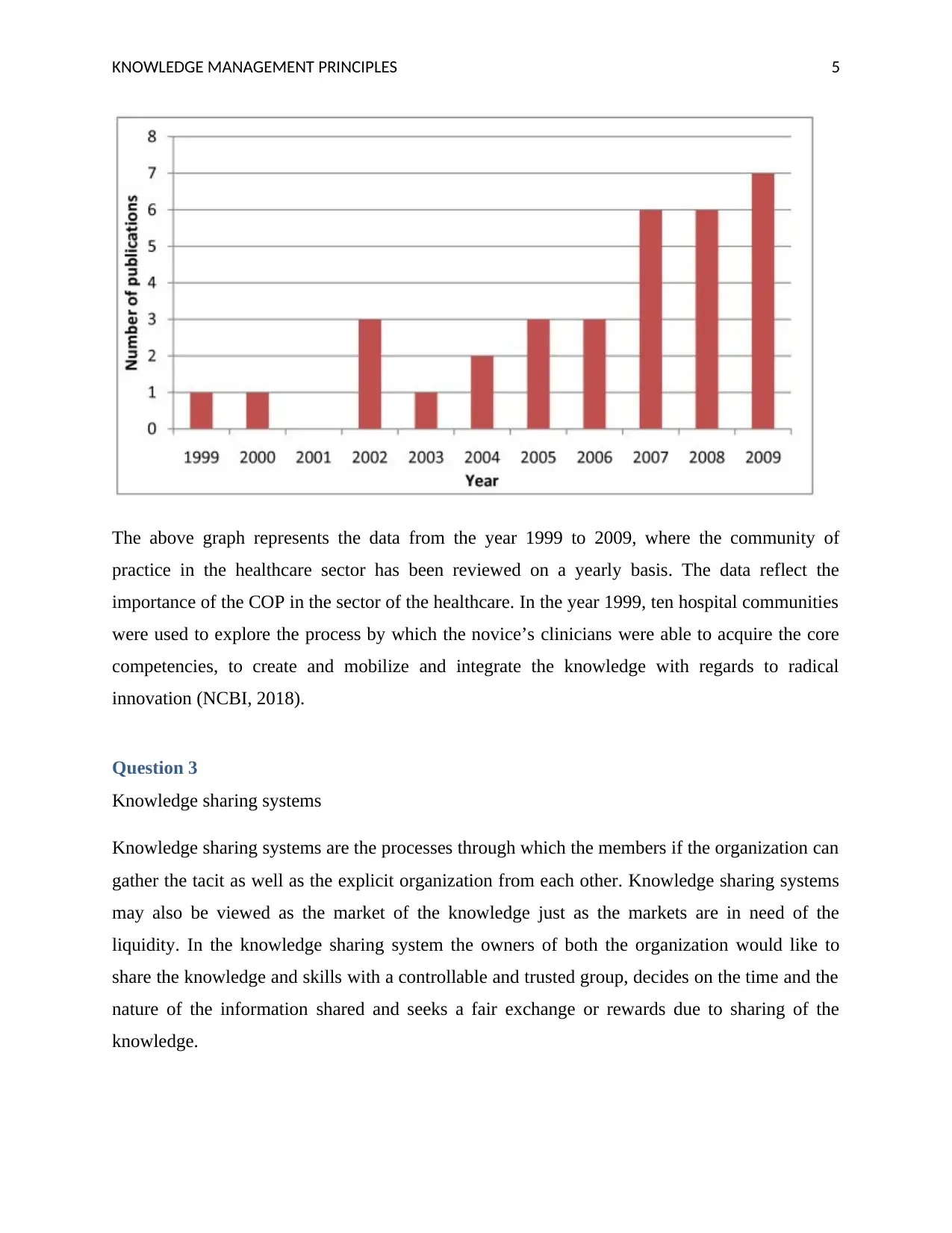
KNOWLEDGE MANAGEMENT PRINCIPLES 5
The above graph represents the data from the year 1999 to 2009, where the community of
practice in the healthcare sector has been reviewed on a yearly basis. The data reflect the
importance of the COP in the sector of the healthcare. In the year 1999, ten hospital communities
were used to explore the process by which the novice’s clinicians were able to acquire the core
competencies, to create and mobilize and integrate the knowledge with regards to radical
innovation (NCBI, 2018).
Question 3
Knowledge sharing systems
Knowledge sharing systems are the processes through which the members if the organization can
gather the tacit as well as the explicit organization from each other. Knowledge sharing systems
may also be viewed as the market of the knowledge just as the markets are in need of the
liquidity. In the knowledge sharing system the owners of both the organization would like to
share the knowledge and skills with a controllable and trusted group, decides on the time and the
nature of the information shared and seeks a fair exchange or rewards due to sharing of the
knowledge.
The above graph represents the data from the year 1999 to 2009, where the community of
practice in the healthcare sector has been reviewed on a yearly basis. The data reflect the
importance of the COP in the sector of the healthcare. In the year 1999, ten hospital communities
were used to explore the process by which the novice’s clinicians were able to acquire the core
competencies, to create and mobilize and integrate the knowledge with regards to radical
innovation (NCBI, 2018).
Question 3
Knowledge sharing systems
Knowledge sharing systems are the processes through which the members if the organization can
gather the tacit as well as the explicit organization from each other. Knowledge sharing systems
may also be viewed as the market of the knowledge just as the markets are in need of the
liquidity. In the knowledge sharing system the owners of both the organization would like to
share the knowledge and skills with a controllable and trusted group, decides on the time and the
nature of the information shared and seeks a fair exchange or rewards due to sharing of the
knowledge.
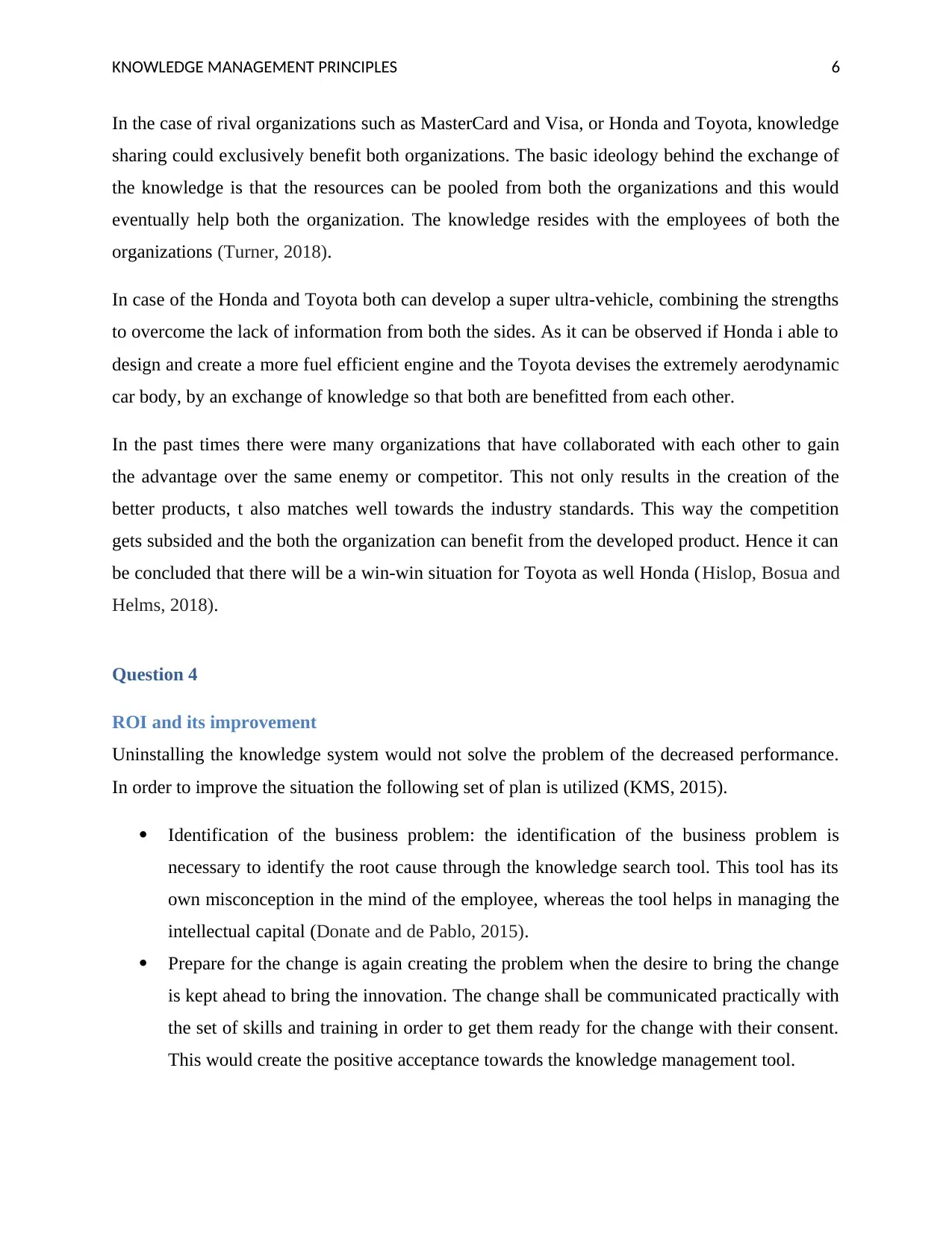
KNOWLEDGE MANAGEMENT PRINCIPLES 6
In the case of rival organizations such as MasterCard and Visa, or Honda and Toyota, knowledge
sharing could exclusively benefit both organizations. The basic ideology behind the exchange of
the knowledge is that the resources can be pooled from both the organizations and this would
eventually help both the organization. The knowledge resides with the employees of both the
organizations (Turner, 2018).
In case of the Honda and Toyota both can develop a super ultra-vehicle, combining the strengths
to overcome the lack of information from both the sides. As it can be observed if Honda i able to
design and create a more fuel efficient engine and the Toyota devises the extremely aerodynamic
car body, by an exchange of knowledge so that both are benefitted from each other.
In the past times there were many organizations that have collaborated with each other to gain
the advantage over the same enemy or competitor. This not only results in the creation of the
better products, t also matches well towards the industry standards. This way the competition
gets subsided and the both the organization can benefit from the developed product. Hence it can
be concluded that there will be a win-win situation for Toyota as well Honda (Hislop, Bosua and
Helms, 2018).
Question 4
ROI and its improvement
Uninstalling the knowledge system would not solve the problem of the decreased performance.
In order to improve the situation the following set of plan is utilized (KMS, 2015).
Identification of the business problem: the identification of the business problem is
necessary to identify the root cause through the knowledge search tool. This tool has its
own misconception in the mind of the employee, whereas the tool helps in managing the
intellectual capital (Donate and de Pablo, 2015).
Prepare for the change is again creating the problem when the desire to bring the change
is kept ahead to bring the innovation. The change shall be communicated practically with
the set of skills and training in order to get them ready for the change with their consent.
This would create the positive acceptance towards the knowledge management tool.
In the case of rival organizations such as MasterCard and Visa, or Honda and Toyota, knowledge
sharing could exclusively benefit both organizations. The basic ideology behind the exchange of
the knowledge is that the resources can be pooled from both the organizations and this would
eventually help both the organization. The knowledge resides with the employees of both the
organizations (Turner, 2018).
In case of the Honda and Toyota both can develop a super ultra-vehicle, combining the strengths
to overcome the lack of information from both the sides. As it can be observed if Honda i able to
design and create a more fuel efficient engine and the Toyota devises the extremely aerodynamic
car body, by an exchange of knowledge so that both are benefitted from each other.
In the past times there were many organizations that have collaborated with each other to gain
the advantage over the same enemy or competitor. This not only results in the creation of the
better products, t also matches well towards the industry standards. This way the competition
gets subsided and the both the organization can benefit from the developed product. Hence it can
be concluded that there will be a win-win situation for Toyota as well Honda (Hislop, Bosua and
Helms, 2018).
Question 4
ROI and its improvement
Uninstalling the knowledge system would not solve the problem of the decreased performance.
In order to improve the situation the following set of plan is utilized (KMS, 2015).
Identification of the business problem: the identification of the business problem is
necessary to identify the root cause through the knowledge search tool. This tool has its
own misconception in the mind of the employee, whereas the tool helps in managing the
intellectual capital (Donate and de Pablo, 2015).
Prepare for the change is again creating the problem when the desire to bring the change
is kept ahead to bring the innovation. The change shall be communicated practically with
the set of skills and training in order to get them ready for the change with their consent.
This would create the positive acceptance towards the knowledge management tool.
⊘ This is a preview!⊘
Do you want full access?
Subscribe today to unlock all pages.

Trusted by 1+ million students worldwide
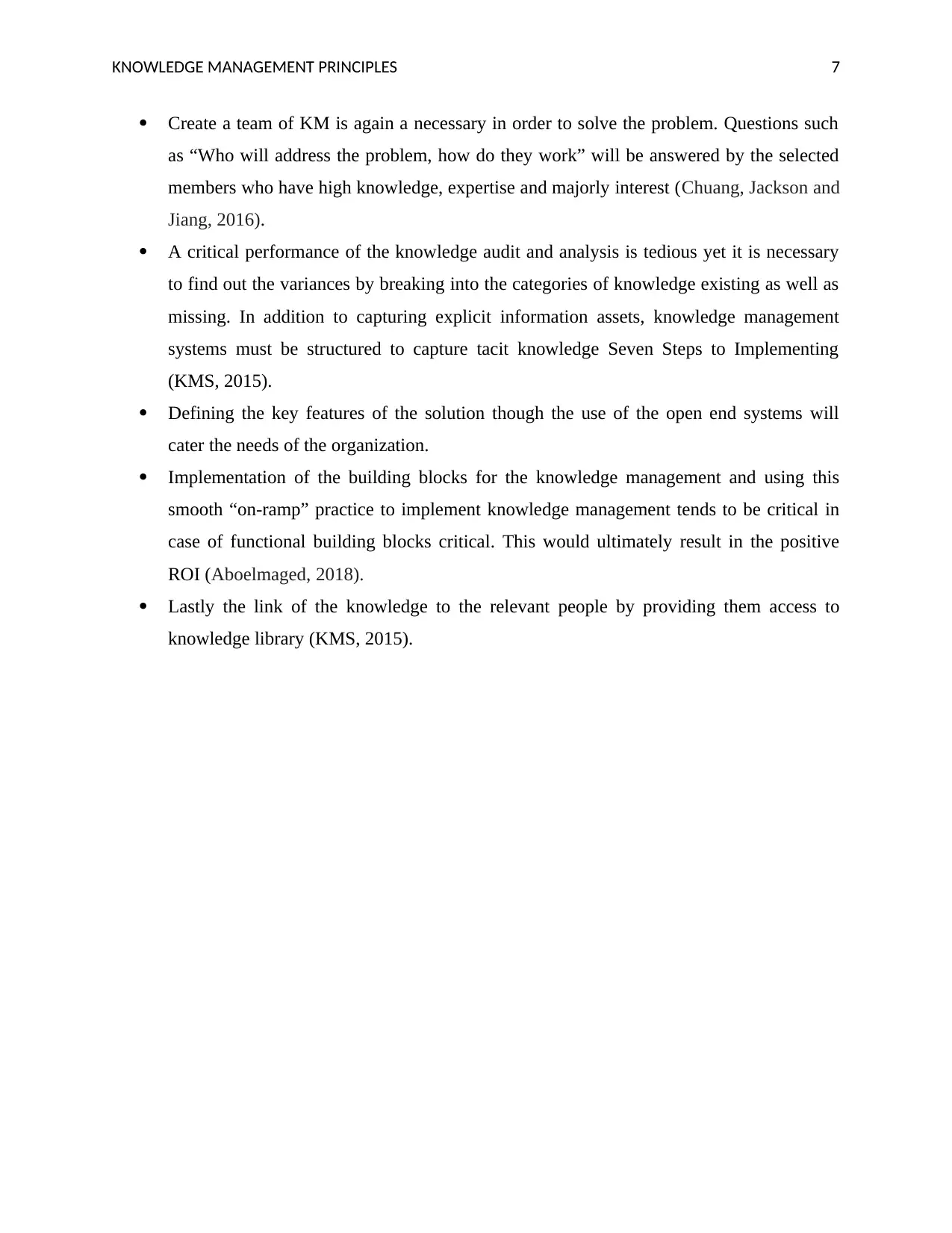
KNOWLEDGE MANAGEMENT PRINCIPLES 7
Create a team of KM is again a necessary in order to solve the problem. Questions such
as “Who will address the problem, how do they work” will be answered by the selected
members who have high knowledge, expertise and majorly interest (Chuang, Jackson and
Jiang, 2016).
A critical performance of the knowledge audit and analysis is tedious yet it is necessary
to find out the variances by breaking into the categories of knowledge existing as well as
missing. In addition to capturing explicit information assets, knowledge management
systems must be structured to capture tacit knowledge Seven Steps to Implementing
(KMS, 2015).
Defining the key features of the solution though the use of the open end systems will
cater the needs of the organization.
Implementation of the building blocks for the knowledge management and using this
smooth “on-ramp” practice to implement knowledge management tends to be critical in
case of functional building blocks critical. This would ultimately result in the positive
ROI (Aboelmaged, 2018).
Lastly the link of the knowledge to the relevant people by providing them access to
knowledge library (KMS, 2015).
Create a team of KM is again a necessary in order to solve the problem. Questions such
as “Who will address the problem, how do they work” will be answered by the selected
members who have high knowledge, expertise and majorly interest (Chuang, Jackson and
Jiang, 2016).
A critical performance of the knowledge audit and analysis is tedious yet it is necessary
to find out the variances by breaking into the categories of knowledge existing as well as
missing. In addition to capturing explicit information assets, knowledge management
systems must be structured to capture tacit knowledge Seven Steps to Implementing
(KMS, 2015).
Defining the key features of the solution though the use of the open end systems will
cater the needs of the organization.
Implementation of the building blocks for the knowledge management and using this
smooth “on-ramp” practice to implement knowledge management tends to be critical in
case of functional building blocks critical. This would ultimately result in the positive
ROI (Aboelmaged, 2018).
Lastly the link of the knowledge to the relevant people by providing them access to
knowledge library (KMS, 2015).
Paraphrase This Document
Need a fresh take? Get an instant paraphrase of this document with our AI Paraphraser
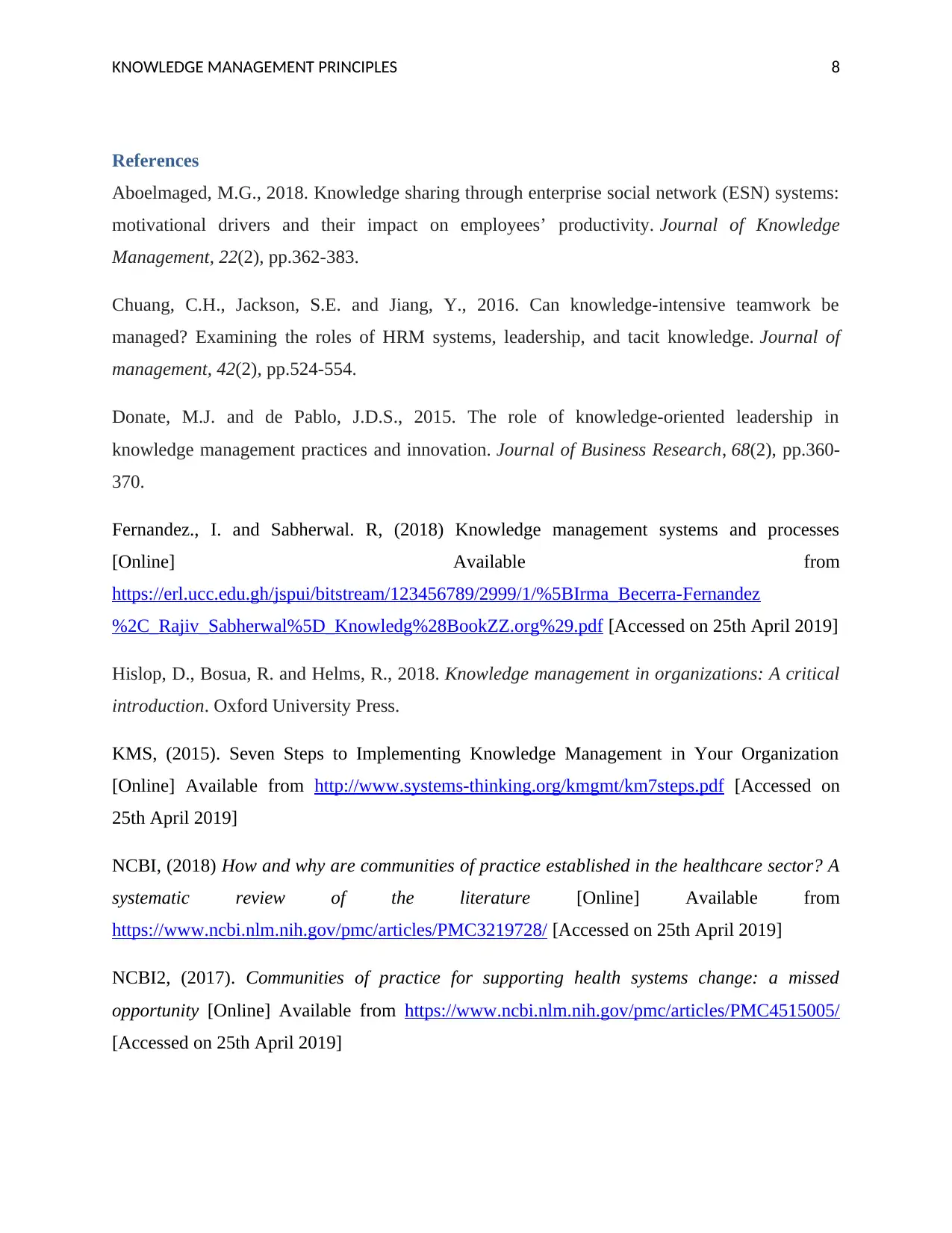
KNOWLEDGE MANAGEMENT PRINCIPLES 8
References
Aboelmaged, M.G., 2018. Knowledge sharing through enterprise social network (ESN) systems:
motivational drivers and their impact on employees’ productivity. Journal of Knowledge
Management, 22(2), pp.362-383.
Chuang, C.H., Jackson, S.E. and Jiang, Y., 2016. Can knowledge-intensive teamwork be
managed? Examining the roles of HRM systems, leadership, and tacit knowledge. Journal of
management, 42(2), pp.524-554.
Donate, M.J. and de Pablo, J.D.S., 2015. The role of knowledge-oriented leadership in
knowledge management practices and innovation. Journal of Business Research, 68(2), pp.360-
370.
Fernandez., I. and Sabherwal. R, (2018) Knowledge management systems and processes
[Online] Available from
https://erl.ucc.edu.gh/jspui/bitstream/123456789/2999/1/%5BIrma_Becerra-Fernandez
%2C_Rajiv_Sabherwal%5D_Knowledg%28BookZZ.org%29.pdf [Accessed on 25th April 2019]
Hislop, D., Bosua, R. and Helms, R., 2018. Knowledge management in organizations: A critical
introduction. Oxford University Press.
KMS, (2015). Seven Steps to Implementing Knowledge Management in Your Organization
[Online] Available from http://www.systems-thinking.org/kmgmt/km7steps.pdf [Accessed on
25th April 2019]
NCBI, (2018) How and why are communities of practice established in the healthcare sector? A
systematic review of the literature [Online] Available from
https://www.ncbi.nlm.nih.gov/pmc/articles/PMC3219728/ [Accessed on 25th April 2019]
NCBI2, (2017). Communities of practice for supporting health systems change: a missed
opportunity [Online] Available from https://www.ncbi.nlm.nih.gov/pmc/articles/PMC4515005/
[Accessed on 25th April 2019]
References
Aboelmaged, M.G., 2018. Knowledge sharing through enterprise social network (ESN) systems:
motivational drivers and their impact on employees’ productivity. Journal of Knowledge
Management, 22(2), pp.362-383.
Chuang, C.H., Jackson, S.E. and Jiang, Y., 2016. Can knowledge-intensive teamwork be
managed? Examining the roles of HRM systems, leadership, and tacit knowledge. Journal of
management, 42(2), pp.524-554.
Donate, M.J. and de Pablo, J.D.S., 2015. The role of knowledge-oriented leadership in
knowledge management practices and innovation. Journal of Business Research, 68(2), pp.360-
370.
Fernandez., I. and Sabherwal. R, (2018) Knowledge management systems and processes
[Online] Available from
https://erl.ucc.edu.gh/jspui/bitstream/123456789/2999/1/%5BIrma_Becerra-Fernandez
%2C_Rajiv_Sabherwal%5D_Knowledg%28BookZZ.org%29.pdf [Accessed on 25th April 2019]
Hislop, D., Bosua, R. and Helms, R., 2018. Knowledge management in organizations: A critical
introduction. Oxford University Press.
KMS, (2015). Seven Steps to Implementing Knowledge Management in Your Organization
[Online] Available from http://www.systems-thinking.org/kmgmt/km7steps.pdf [Accessed on
25th April 2019]
NCBI, (2018) How and why are communities of practice established in the healthcare sector? A
systematic review of the literature [Online] Available from
https://www.ncbi.nlm.nih.gov/pmc/articles/PMC3219728/ [Accessed on 25th April 2019]
NCBI2, (2017). Communities of practice for supporting health systems change: a missed
opportunity [Online] Available from https://www.ncbi.nlm.nih.gov/pmc/articles/PMC4515005/
[Accessed on 25th April 2019]
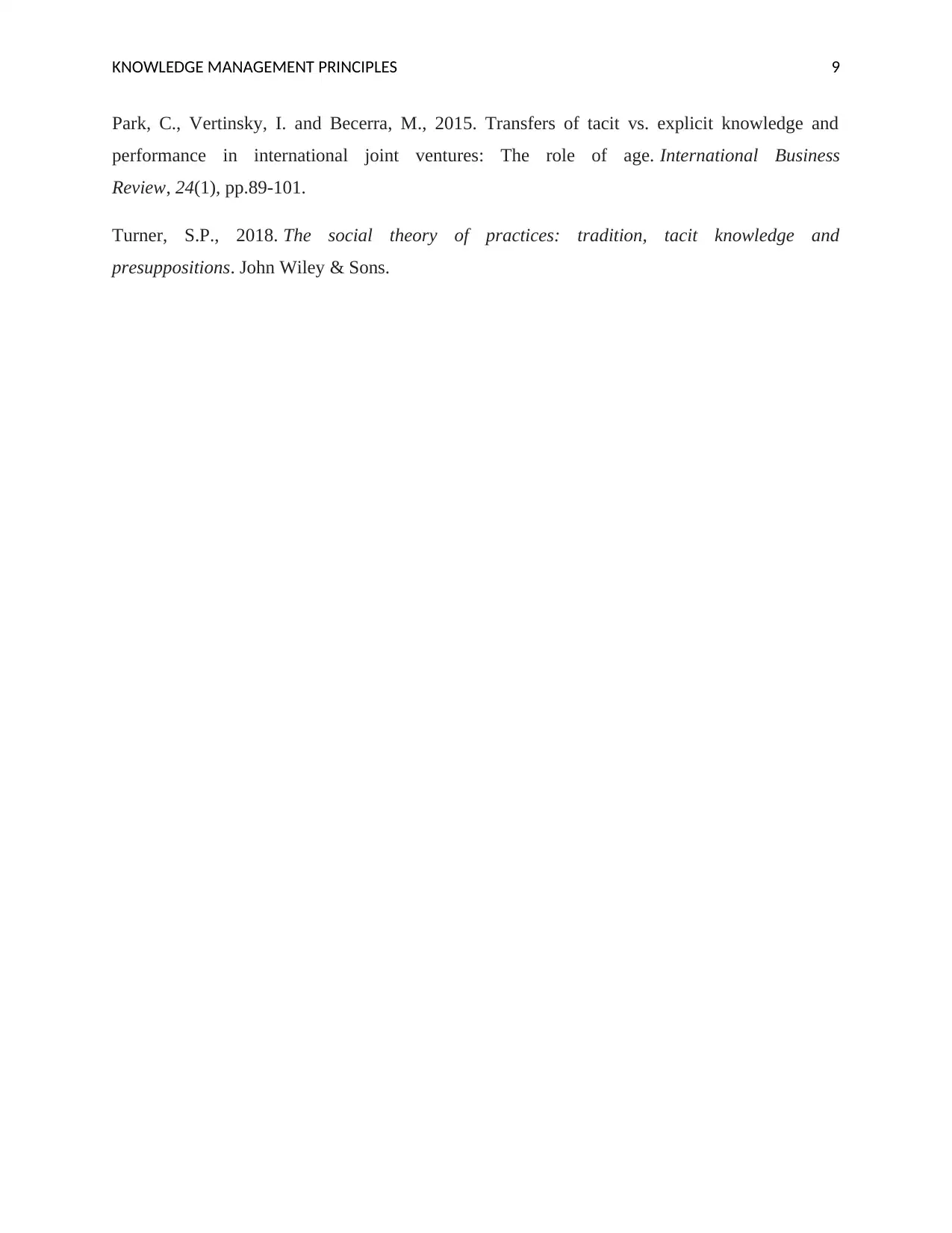
KNOWLEDGE MANAGEMENT PRINCIPLES 9
Park, C., Vertinsky, I. and Becerra, M., 2015. Transfers of tacit vs. explicit knowledge and
performance in international joint ventures: The role of age. International Business
Review, 24(1), pp.89-101.
Turner, S.P., 2018. The social theory of practices: tradition, tacit knowledge and
presuppositions. John Wiley & Sons.
Park, C., Vertinsky, I. and Becerra, M., 2015. Transfers of tacit vs. explicit knowledge and
performance in international joint ventures: The role of age. International Business
Review, 24(1), pp.89-101.
Turner, S.P., 2018. The social theory of practices: tradition, tacit knowledge and
presuppositions. John Wiley & Sons.
⊘ This is a preview!⊘
Do you want full access?
Subscribe today to unlock all pages.

Trusted by 1+ million students worldwide
1 out of 9
Related Documents
Your All-in-One AI-Powered Toolkit for Academic Success.
+13062052269
info@desklib.com
Available 24*7 on WhatsApp / Email
![[object Object]](/_next/static/media/star-bottom.7253800d.svg)
Unlock your academic potential
Copyright © 2020–2025 A2Z Services. All Rights Reserved. Developed and managed by ZUCOL.




